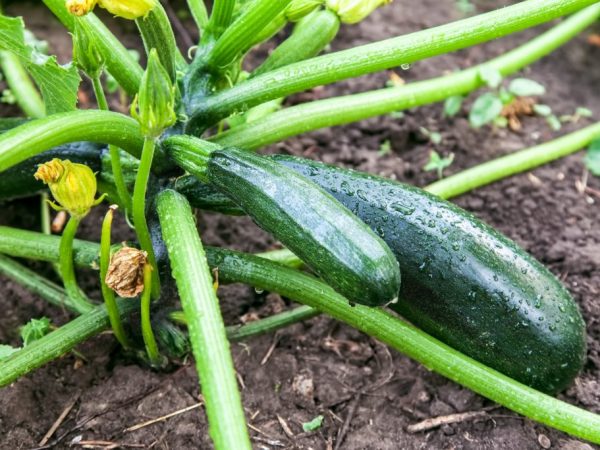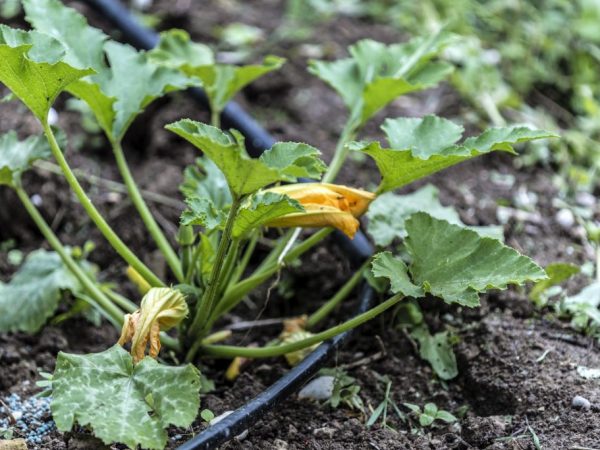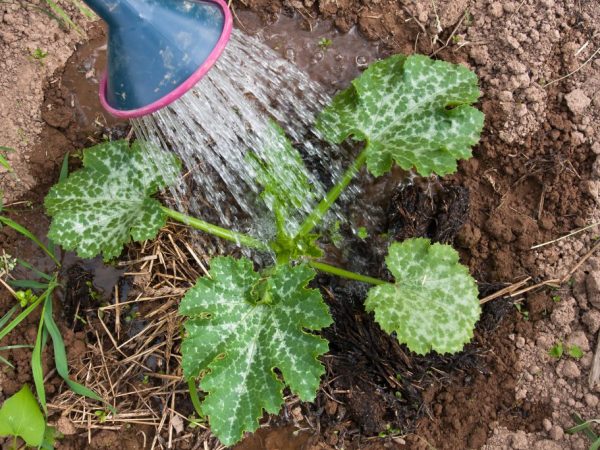Rules for watering zucchini in the open field
To get a good harvest, it is worth following certain rules. Watering zucchini outdoors is an integral part of crop care. In order not to harm the plants, you should know how to properly moisturize the soil.

Rules for watering zucchini in the open field
Watering features
Depending on the method of planting, the site begins to be watered at different times.
If the seedling method is chosen, then for the first time the soil is moistened when the plants take root. When seeds are planted in open ground, then watering is done with the appearance of sprouts.
The procedure is best done in the morning. The water must be used warm - 20 ° C, otherwise the plants will start to hurt. Too high a temperature of the liquid will heat the roots. And after they cool down, the growth of culture will slow down.
Plants can be watered at an average daily temperature of at least 15 ° C above zero.
Water is brought in at the root. Do this carefully so that it does not fall on the leaves. The jet should not be too strong. Otherwise, the roots of the plant are washed out. If this happens, the bush must be hilled. It is better to take the earth from another bed, so as not to catch the root system.
Watering in the garden
The choice of wetting method depends on the planting area.
Dosed watering
To implement this method, it is worth performing the following manipulations:
- take large plastic bottles;
- cut holes in the lids so that water drips;
- at a distance of 15-20 cm from the plant, make a depression of 10-15 cm;
- put the prepared vessel upside down into it at an angle of 45˚.
Water will flow to the roots of the squash. You need to add it as you consume.
Bottles can also be hung over bushes. Holes in the lids are not made, but only slightly unscrewed. In the place where the drops will fall, lay a film or mulch so that the soil does not wash out.
Watering with a "wick"
The method is classified as one of the most economical. It provides for the use of containers with water, which are suitable for old buckets, bottles, basins, etc. They are installed every few meters.
A tourniquet is made of fabric, which will serve as a kind of wick. One end of it is placed in a container, the second is buried to a depth of 10-15 cm along a row.
The fabric will be soaked in water along the entire "wick". The liquid will gradually saturate the ground with moisture, reaching the roots.
Jet irrigation

For spray irrigation you need a hose
It is worth purchasing a hose for this method. Holes are made in it along the entire length. Then the device is buried at a shallow depth and connected to the water supply system.
This method of watering zucchini is also cost effective because the liquid will flow directly to the roots without evaporating. If the process is done correctly, the ground on the surface will be dry.
Industrial irrigation
The method is chosen based on the capabilities of the farmer.They also take into account the topography of the field and access to water resources.
Subsoil
Laying metal or polymer pipes. They must meet the following requirements:
- go parallel to the rows;
- be located at a depth of 25-40 cm;
- have holes.
Water is connected from the main pipeline. With this method of irrigation, a crust does not form, but it is difficult to regulate the flow of liquid.
Sprinkling
Water is supplied from the sediment through a pipeline under a pressure of 2-3 atm. Large droplets form on the nozzles. This method is often used when water is dispersed in the form of fog. The consumption then turns out to be low - 200-600 ml of liquid per 1 sq. m, but in this case, watering the zucchini will have to be done many times.
The advantages of the method include:
- uniformity of watering;
- saving water;
- high productivity.
Among the disadvantages is the evaporation of moisture from the ground. The equipment is expensive, so not every company can install it.
Gravity
The method has 2 subspecies:
- furrowed - water is supplied to the zucchini along the furrows. The method is cheap. The liquid consumption is large, but it is supplied unevenly to different areas;
- estuary - flood the field. After that, the earth is compacted, a crust forms. The method is characterized by excessive consumption of water, but it does not require large other costs.
Drip
A polymeric drip tape is installed in the planting aisles. The fluid is delivered at a programmed rate. It goes to the roots of the plant.
This is one of the most modern and high-tech methods. It can even be used on slopes. In order not to clog the droppers, the water must be perfectly clean with low mineralization. The equipment is expensive.
Soil moisture level

Young plants are recommended to be watered once a week.
It is necessary that the soil under the crop be moistened to a depth of 30-40 cm.There are recommendations on how often the zucchini should be watered:
- before the beginning of fruiting - 1 time for 5-7 days, 9-10 liters of water per 1 sq. m;
- during the fruiting period - 2-3 times a week, 15-20 liters of water per 1 sq. m.
Until the time when fruits begin to form, the spring moisture in the soil dries up. During this period, the amount of fluid is increased, especially if the heat is on the street. Do not allow the soil to dry out. In rainy weather, watering is suspended.
The amount of liquid is adjusted according to the particle size distribution of the soil. The chosen watering method also matters.
Influence of excess moisture
Water stagnation near the roots should not be allowed. Grooves are made to drain it during the rainy season. If necessary, build a canopy over the landings. Failure to comply with these conditions threatens with the following consequences:
- decreased plant immunity. Because of this, fungal diseases develop;
- the formation of predominantly superficial roots. Excess moisture interferes with the free access of oxygen, so the root hairs die off;
- inhibition of plant growth - although at the first stages of formation, a large amount of liquid contributes to intensive development;
- decay of fruit tips. They can be cut and burned at the cut, but it is better to rip off;
- decrease in sugar content.
Consequences of a lack of moisture
Lack of water is harmful to the crop, especially during the first half of the growing season. Even a short-term drought provokes a decrease in yield.
Lack of moisture negatively affects planting:
- more male flowers are formed than female flowers - in this case, the harvest is not expected;
- zucchini are formed small;
- the growth of culture slows down;
- the taste of fruits decreases - they begin to taste bitter.
To keep moisture in the ground longer, zucchini are mulched. To do this, you can use humus, matured compost, rotted straw. Mulch is laid in a layer of 2-3 cm.When using it, the bushes will receive additional nutrients.
General instructions
Water zucchini should be timely and abundant.They are 77% water, so the need for it is great. The liquid carries nutrients throughout the plant. Regulates the temperature of the culture.
Regardless of the chosen method of irrigation, it is worth adhering to its main rule - the water must be settled and warm. Observing all the features of care, the gardener will be able to get a high and high-quality harvest.

